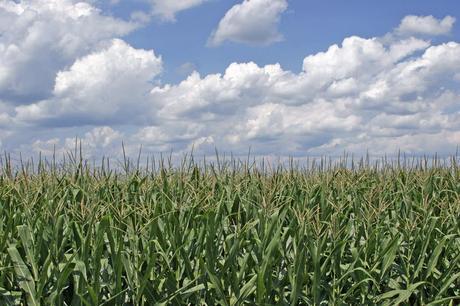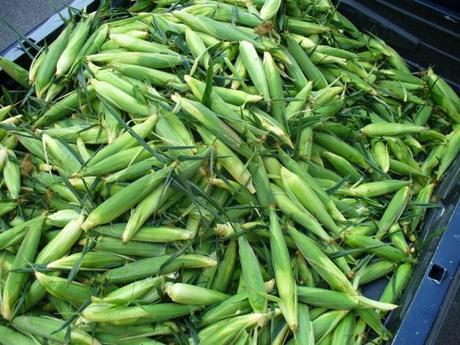Continuing the erratically-scheduled Seed saving 101 series…
Saving Sweet Corn
Who doesn’t love corn? But when each plant yields only 2 ears or so, it can be hard for the average home gardener to maintain a reasonable population size to permit good genetic diversity and account for seasonal attrition.

Ohio corn field By Graylight (Flickr) [CC-BY-2.0 (http://creativecommons.org/licenses/by/2.0)%5D, via Wikimedia Commons
Corn is wind-pollinated, and to prevent cross-pollination for seed-saving purposes you must maintain more than 1/3 mile (some sources say more than ½ mile) between your corn and anyone else’s. If you live in a typical American suburban cul-de-sac development, avoiding contamination might be impossible if anyone else on your block grows corn. If you don’t have 200 plants, you might be able to use row covers to shelter your corn from other varieties. Frames can be made out of flexible PVC piping that are both inexpensive and can support row covers, but this might be more work than you want to do.A short word about GMOs: In 2010, 86% of the corn planted commercially in the US contained some modified genetics.[1] Genetically modified corn seed, such as Monsanto’s Roundup-Ready seed, is not sold to the home gardening market. However, a 2004 pilot study by the Union of Concerned Scientists found that modified genes had found their way into 50% of the non-GMO corn seed they tested. Their test seeds had been purchased from the same retailers that sell to US farmers. The UCS data suggest a 1% contamination rate in the seeds of traditional varieties, which equates to 6250 tons of transgenically-derived seeds planted in fields of traditional crops.[2] In 2004, approximately 81 million acres of corn were planted in the US, and 45% of all corn planted were biotech varieties.[3] In 2013, that amount had grown to 97.4 million acres, of which 90% were biotech varieties.[4] Such statistics suggest that in the past ten years since the UCS pilot study, accidental contamination of non-GMO seed stocks may have also increased, and may have found its way to a corn seed packet near you. And if you live within approximately 1/3 to ½ mile of a farm where corn is grown commercially (particularly for commodity corn, used in the production of ethanol or for livestock feed), the potential for direct GMO cross-pollination with your home-grown crop exists.

Truckload of corn, Wikipedia photo released to public domain.
Hybrids are not the same as genetically modified organisms, but seed saved from hybrid corn will not come true. Open-pollinated corn may cross with nearby hybrid varieties by wind pollination, which may result in unfavorable traits in your second-generation corn seed. Sweet corn will also cross-pollinate with field corn and ornamental corn, resulting in less-sweet sweet corn.
How to grow and save the seed:
Plant your corn in blocks, not rows, to ensure the heavy pollen fully fertilizes all the seeds and the ears fully develop. Hand pollination is simple and is a good way to control the fertilization (and prevent cross-fertilization) of your corn:
- Place bags around the ears of corn before the silks emerge, securing the bags tightly.
- Separately bag the tassel, which contains the pollen.
- Shake the pollen from the tassel and allow it to collect in the bag.
- Then de-bag the ears, shake the pollen onto the silks, and re-bag the ears to prevent cross-pollination.
To harvest seed:
Allow the ears to dry on the plant. For sweet corn, harvest when a fingernail pressed into a kernel releases a milky fluid.[5] Peel back the browned husks and allow the seeds to dry on the cob in a well-ventilated space. Twisting the dried ears will encourage the kernels to fall off the cobs, and you may also rub the kernels off by hand.[6] Store in a glass jar in a refrigerator or other cool, dark place.
Further tips on saving corn seed may be found at the Seedsavers.org blog, http://blog.seedsavers.org/preventing-gmo-contamination-in-your-open-pollinated-corn/.
[1] Acreage, Released June 30, 2010, by the National Agricultural Statistics Service (NASS), Agricultural Statistics Board, U.S. Department of Agriculture. Pp. 24, 32. http://usda.mannlib.cornell.edu/usda/nass/Acre/2010s/2010/Acre-06-30-2010.pdf
[2] Gone to Seed: Transgenic Contaminants in the Traditional Seed Supply. (pp. 1-2). Union of Concerned Scientists, Cambridge, MA: 2004. http://www.ucsusa.org/assets/documents/food_and_agriculture/seedreport_fullreport.pdf
[3] Acreage, 2004. National Agricultural Statistics Service (NASS), Agricultural Statistics Board, US Department of Agriculture, p. 24. http://usda01.library.cornell.edu/usda/nass/Acre//2000s/2004/Acre-06-30-2004.pdf,
[4] Acreage, 2013. National Agricultural Statistics Service (NASS), Agricultural Statistics Board, US Department of Agriculture, p. 25. http://usda01.library.cornell.edu/usda/current/Acre/Acre-06-28-2013.pdf
[5] http://www.nativeseeds.org/resources/seedsaving
[6] http://www.seedsave.org/issi/904/experienced.html

